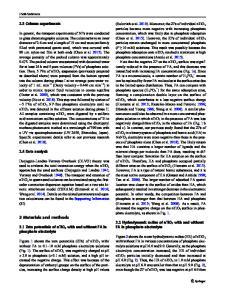Morphology and Electronic Structures of Calcium Phosphate Coated Titanium Dioxide Nanotubes
- PDF / 234,373 Bytes
- 6 Pages / 432 x 648 pts Page_size
- 68 Downloads / 295 Views
Morphology and Electronic Structures of Calcium Phosphate Coated Titanium Dioxide Nanotubes Lijia Liu, Sun Kim, Jeffrey Chan and Tsun-Kong Sham Department of Chemistry, University of Western Ontario London, ON N6A5B7, Canada ABSTRACT Titanium dioxide nanotubes (TiO2-NT) have been synthesized via an electrochemical anodization strategy followed by calcination under different temperatures to form TiO2 nanostructures of anatase and rutile crystal phases. The nanotube-on-Ti structure is further used as a substrate for calcium hydroxyapatite (HAp) coating. The effect of TiO2 morphology and crystal phases (i.e. amorphous, anatase and rutile) on the coating efficiency of HAp has been investigated in comparison with HAp coating on bare Ti metal. The HAp coated TiO2-NT have been studied using X-ray absorption near-edge structure (XANES) at the Ti K- and Ca K-edge. The results show that TiO2 of amorphous and anatase phases are of comparably good performance for HAp crystallization, and both are better than rutile TiO2, while HAp is hardly found on bare Ti. The implications of the findings are discussed. INTRODUCTION Titanium has been widely recognized as an orthopedic implants material due to its light weight and high bio-compatibility [1]. However, due to its metallic property, the interaction between Ti and bones are not strong enough, which limits the practical application. Effort has been made to increase the surface area of Ti by decrease the size of Ti to small scales [2] or by growing a porous layer [3-4], which is typically oxide on Ti surface. The latter, which can be achieved by acid or alkali etching a Ti foil, provides a layer of porous TiO2 or TiO2 nanotubes directly attached to the metallic Ti substrate. It is known that TiO2 has various crystal phases, among which anatase and rutile are most common. It is thus desirable to find out which crystal phase of TiO2 could serve as a better interface for bone-implant interaction. Calcium hydroxyapatite (HAp), Ca10(PO4)6(OH)2, is one of the calcium orthophosphates (Ca-P) compounds. It is of particular interest due to its high stability and low solubility, thus it becomes an ideal coating material of the metal implant in order to enhance the bone bonding and implant fixation [5]. HAp can crystallize directly from simulated body fluid (SBF) under appropriate conditions. However, due to the complicated crystallization process [6], whether or not the Ca-P compound crystallized from SBF is in fact, having the HAp structure, is still not entirely clear. In this study, TiO2-NT of amorphous, anatase, and rutile structure are synthesized via electrochemical anodization followed by calcination. Our previous study suggests that TiO2-NT can crystallize from amorphous to anatase and further to
63
rutile by controlling the calcination temperature [7]. The TiO2-NT samples are thus used as substrates for HAp coating. The electronic structures of TiO2-NT and HAp are examined using X-ray absorption near-edge structures (XANES) at Ti K- and Ca K-edge. XANES is an X-ray spectroscopic te
Data Loading...











